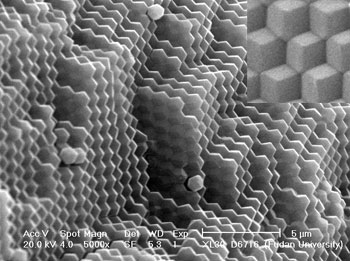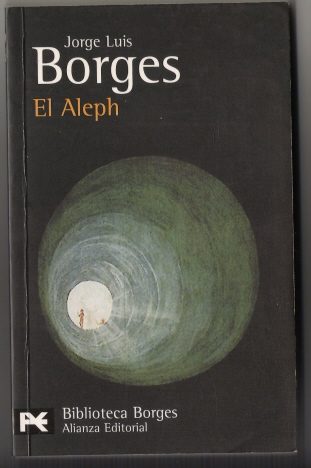Make your bet compressed matter or antimatter packs as the pomegranate seeds, leaves no vacuum filling all space
and so reflect its microcosmos geometry to the macrocosmos in the same way as calcite rhombic crystals.
Garnet crystal which has a rhombic dodecahedron form gave the name to the underworld pomegranate fruit of Persephone.
Rhombic dodecahedron packed crystals are photonic because they don't leave place to defects essential for photonic material.

The close packing of the dodecahedral particles mean the crystal structure has very few defects - essential for photonic materials
Photonic materials precisely change the flow of light moving through them because they are made up of alternating regions of high and low dielectric constant. An example seen in nature is opal, whose play of colour is due to its nanostructure, not absorption bands as in most gems.
http://en.wikipedia.org/wiki/Large_Electron%E2%80%93Positron_Collider#OPALOPAL
OPAL stands for Omni-Purpose Apparatus for LEP. The detector was dismantled in 2000 to make way for LHC equipment. The lead glass blocks from the OPAL barrel electromagnetic calorimeter are currently being re-used by the NA62 experiment at CERN. The name was a pun since some of the founding members of the scientific collaboration which first proposed the design had previously worked on the JADE detector at DESY in Hamburg.[3
And we also have Aleph, Delphi oracle and Atlas galactic center keys in Cern.
ALEPH
ALEPH stands for Apparatus for LEP PHysics at CERN. The detector determined the mass of the W-boson and Z-boson to within one part in a thousand. The number of families of particles with light neutrinos was determined to be 2.982±0.013, which is consistent with the standard model value of 3. The running of the quantum chromodynamics (QCD) coupling constant was measured at various energies and found to run in accordance with perturbative calculations in QCD.[2]
[edit]
DELPHI
Main article: DELPHI experiment
DELPHI stands for DEtector with Lepton, Photon and Hadron Identification.
Atlas is a Torus, the hypercube is the quadrature of the Torus as the rhombus to the vesica piscishttp://en.wikipedia.org/wiki/ATLAS_experimentATLAS (A Toroidal LHC Apparatus) is one of the seven particle detector experiments (ALICE, ATLAS, CMS, TOTEM, LHCb, LHCf and MoEDAL) constructed at the Large Hadron Collider (LHC), a new particle accelerator at the European Organization for Nuclear Research (CERN) in Switzerland. ATLAS is 44 metres long and 25 metres in diameter, weighing about 7,000 tonnes. The project is led by Fabiola Gianotti and involves roughly 2,000 scientists and engineers at 165 institutions in 35 countries.[1][2] The construction was originally scheduled to be completed in June 2007, but was ready and detected its first beam events on 10 September 2008.[3] The experiment is designed to observe phenomena that involve highly massive particles which were not observable using earlier lower-energy accelerators and might shed light on new theories of particle physics beyond the Standard Model.
 Aleph is Phoenician Alpha - and Omega, the time cycles of XP, the Cris-mon, or Christ mon-key.
Aleph is Phoenician Alpha - and Omega, the time cycles of XP, the Cris-mon, or Christ mon-key.
Delphi the oracle were the two eagles meet, in the constellation of Delphinus doorway of Aquarius leaving
the omphalos egg of creation, symbolized by the Masonic double headed eagle.
Aleph - The quest for immortality
http://en.wikipedia.org/wiki/MagnetarA magnetar is a type of neutron star with an extremely powerful magnetic field, the decay of which powers the emission of high-energy electromagnetic radiation, particularly X-rays and gamma rays.[1] The theory regarding these objects was proposed by Robert Duncan and Christopher Thompson in 1992, but the first recorded burst of gamma rays thought to have been from a magnetar was detected on March 5, 1979.[2] During the following decade, the magnetar hypothesis has become widely accepted as a likely explanation for soft gamma repeaters (SGRs) and anomalous X-ray pulsars (AXPs).
Magnetic field
Magnetars are primarily characterized by their extremely powerful magnetic field, which can often reach the order of ten gigateslas. These magnetic fields are hundreds of millions of times stronger than any man-made magnet,[5] and quadrillions of times more powerful than the field surrounding Earth.[6] Earth has a geomagnetic field of 30–60 microteslas, and a neodymium-based, rare-earth magnet has a field of about 1 tesla, with a magnetic energy density of 4.0×105 J/m3. A 10 gigatesla field, by contrast, has an energy density of 4.0×1025 J/m3, with an E/c2 mass density >104 times that of lead.
The magnetic field of a magnetar would be lethal even at a distance of 1000 km, tearing tissues due to the diamagnetism of water.[citation needed] At a distance halfway to the moon, a magnetar could strip information from the magnetic stripes of all credit cards on Earth.[7] As of 2010, they are the most magnetic objects ever detected in the universe.[4][8]
As described in the February 2003 Scientific American cover story, remarkable things happen within a magnetic field of magnetar strength. "X-ray photons readily split in two or merge together.
The vacuum itself is polarized, becoming strongly birefringent, like a calcite crystal. Atoms are deformed into long cylinders thinner than the quantum-relativistic de Broglie wavelength of an electron."[2] In a field of about 105 teslas atomic orbitals deform into rod shapes. At 1010 teslas, a hydrogen atom becomes a spindle 200 times narrower than its normal diameter.[2]
Opal crystal atomic lattice

